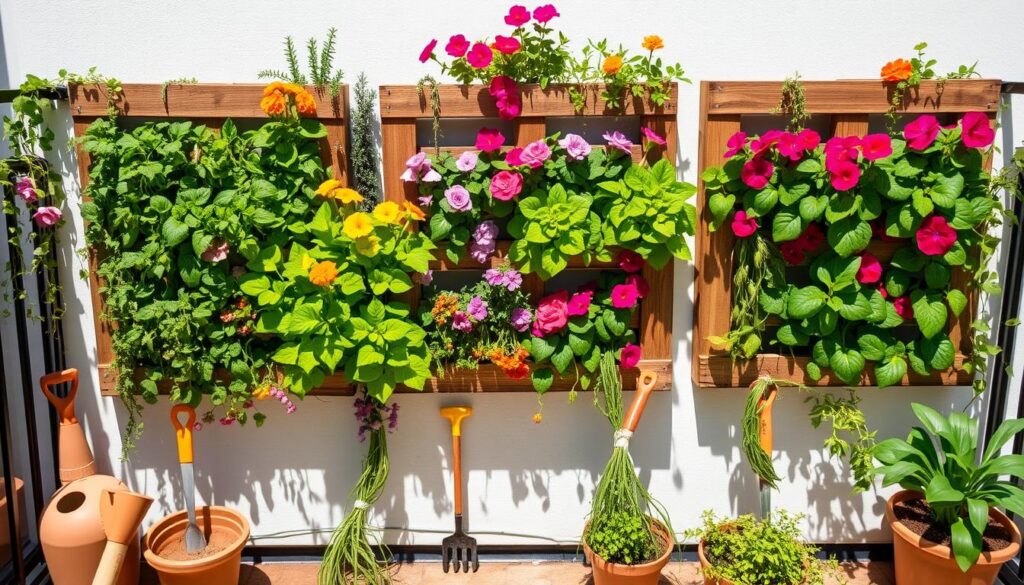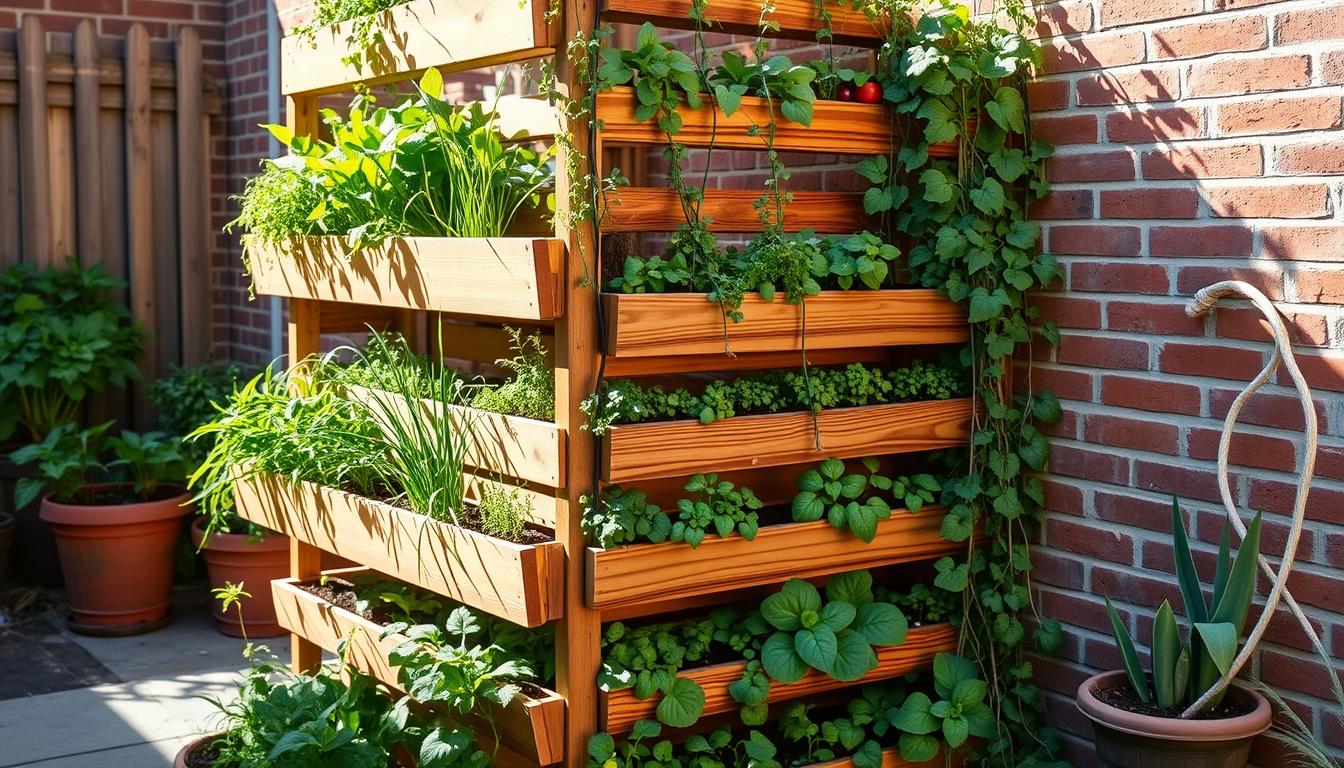Do you want to grow your own food but have a small space? You’re in luck! This DIY guide will teach you to make a vertical vegetable garden for tiny spots like balconies or patios. By going up, you can grow more in less space and have a lush urban garden that fits your needs.

Key Takeaways
- Vertical gardening lets you grow more in a smaller area
- It’s great for small spaces like balconies or patios
- You can design a vertical garden that matches your space
- They’re easy to care for and give you lots of food
- Vertical gardening adds more green to your city life
Introduction to Vertical Gardening
In the world of small-space gardening, vertical gardening is a big change. It lets gardeners use their space better by growing plants up, not out. But what is a vertical vegetable garden, and why is it good for gardening?
What is a Vertical Vegetable Garden?
A vertical vegetable garden grows plants up, using things like trellises or hanging baskets. It’s great for growing veggies, herbs, and some fruits in a small area. It’s perfect for city folks or those with little outdoor space.
Benefits of Growing Vertically
- Increased Yields: You can grow more in a small space, giving you more fresh food.
- Improved Pest and Disease Control: The air moves better, helping to keep pests and diseases away.
- Easier Maintenance: It’s easier to water, prune, and pick your plants because they’re up high.
- Enhanced Aesthetics: Vertical gardens make your outdoor space look beautiful and green.
Whether you live in the city or have a small yard, vertical gardening is a smart choice. It lets you grow your own food in a small space. Knowing about vertical gardening opens up new ways to garden in tight spots.
Planning Your Vertical Garden
Before starting your vertical garden, planning is key. You need to pick the right spot for success. This is the first step.
Choosing the Right Location
Look for a spot that gets enough sunlight. Most veggies need at least 6 hours of direct sun. Also, make sure there’s good air flow to keep plants healthy. And, choose a place that’s easy to get to for upkeep.
Selecting Suitable Vegetables
After finding the perfect spot, pick the right plants. Some top picks include:
- Tomatoes: Go for compact or dwarf types.
- Cucumbers: Use trailing or vining types that can climb.
- Beans: Both bush and pole beans grow well vertically.
- Lettuce: Leafy greens like lettuce and spinach are great.
- Herbs: Basil, thyme, and oregano are perfect for vertical gardens.
By planning well and choosing the right plants, you’ll have a thriving vertical garden. It will be a green oasis in the city.
| Vegetable | Suitability for Vertical Gardens |
|---|---|
| Tomatoes | Excellent, compact or dwarf varieties work well |
| Cucumbers | Excellent, trailing or vining varieties can be trained to climb |
| Beans | Excellent, both bush and pole bean varieties can be grown vertically |
| Lettuce | Excellent, leafy greens like lettuce and spinach adapt well |
| Herbs | Excellent, many aromatic herbs thrive in vertical gardens |
Building the Vertical Structure
Building a strong vertical garden frame is key for a healthy garden. You can choose from simple trellises to complex multi-tiered shelves. Your structure must hold the weight of your plants, offer enough space, and fit your area well.
When designing your vertical garden structures, keep these points in mind:
- Structural Integrity: Pick materials that can handle your plants’ weight, like strong wood, metal, or heavy-duty plastic. Make sure the frame is securely anchored and can hold the full-grown plants.
- DIY vertical garden frame: Building your own DIY vertical garden frame lets you customize it for your space. You can use simple tools and materials to create it.
- Vertical garden design: Choose a vertical garden design that uses space well, like tiered shelves or wall-mounted systems. This way, you can grow more plants in a small area.
- Accessibility: Ensure your vertical structure is easy to reach for planting, watering, and harvesting. Add features like adjustable shelves or a rolling base for better access.
By planning and building the right vertical garden structures, you’ll have a solid base for your thriving garden.
“A well-designed vertical structure is the key to a successful vertical vegetable garden.”
How to Build a Vertical Vegetable Garden for Small Spaces
Are you ready to start your own vertical vegetable garden but don’t know where to start? This guide will help you build a beautiful and productive garden, even in small spaces.
First, let’s get the materials you need. You’ll require a strong frame, like wood or metal, and growing containers. Don’t forget trellises and any extra accessories you want. Measure your space well to make sure the garden fits perfectly.
- Assemble the frame: Follow the instructions or your design to build the frame. Add shelves or tiers to use more vertical space.
- Attach the growing containers: Make sure the containers or planter boxes are level and secure on the frame.
- Install the trellises: Put up the trellises or support systems for plants like tomatoes or cucumbers to grow up.
- Add any additional features: Add irrigation systems, grow lights, or other accessories to improve your garden’s look and function.
For a successful small space garden, plan carefully and arrange plants thoughtfully. Choose a mix of compact, trailing, and vertical plants. This will help your garden look good and use space well.
Now that your garden is built, it’s time to prepare the soil, plant, and maintain it. Stay tuned for more tips to help your garden thrive!
Soil and Planting Preparation
Getting the right soil for your vertical garden is key for healthy plants. To make a soil mix that’s rich in nutrients and drains well, follow these steps:
Creating a Nutrient-Rich Soil Mix
For vertical garden soil, aim for a balance. Mix equal parts of:
- High-quality potting mix or compost
- Perlite or vermiculite for better drainage
- Slow-release organic fertilizer for lasting nutrients
This DIY potting mix for vertical gardens will help your plants grow well. Make sure to mix everything well for a consistent soil preparation for vertical gardening.
After making your soil mix, prepare the planting area. Make sure the vertical structure is level and stable. Then, spread the soil evenly and gently press it down to remove air pockets. But don’t pack it too hard.
Maintaining Your Vertical Garden
To keep your vertical garden healthy and productive, you need to do some regular upkeep. This includes watering, pruning, and trellising. Let’s look at the key steps to help your garden grow well.
Watering Vertical Gardens
Watering your vertical garden right is key for its health. Water deeply, focusing on the roots, not just the surface. This helps the roots grow strong and the plants stay healthy during dry times.
Use a watering can or drip irrigation to water evenly. This avoids soggy soil and stressed plants. It helps your garden stay healthy and strong.
Pruning and Trellising Vertical Vegetables
Pruning and trellising your vertical veggies is important. It keeps them looking good and growing well. Remove any dead or damaged leaves to help the plant grow strong.
Use strong trellises or cages to support the plants. This keeps them tidy and helps them get more sunlight. It also improves air flow, leading to more fruit and veggies.
| Maintenance Task | Frequency | Purpose |
|---|---|---|
| Watering | Every 2-3 days | Maintain soil moisture and plant health |
| Pruning | Every 2-4 weeks | Remove dead, damaged, or diseased foliage |
| Trellising | As needed | Support plant growth and improve air circulation |
By doing these vertical garden maintenance tasks, your vertical vegetables will thrive. They’ll get the right amount of water and care, from watering vertical gardens to pruning and trellising.
Pest and Disease Management
Even the best vertical vegetable garden can face pests and diseases. As an experienced gardener, I’ve found ways to deal with these problems. I use eco-friendly methods to keep my garden healthy.
It’s important to control pests early to prevent problems. I check my plants often for signs of pests or diseases. Catching issues early helps me fix them before they get worse.
- To prevent diseases, I make sure my garden has good air flow. I avoid crowding plants and keep the soil draining well. This helps fight off fungal infections and other diseases.
- For organic pest control, I use natural methods. I introduce beneficial insects, spray with neem oil or insecticidal soap, and pick off pests by hand. These methods are safe for the environment.
By being proactive and using these methods, my vertical garden stays healthy and productive all season.
“The key to a successful vertical garden is to stay one step ahead of any pest or disease issues. With the right preventative measures and quick action, you can keep your plants healthy and productive.”
Harvesting Your Vertical Vegetables
Harvesting your vertical garden is very rewarding. I’ve learned that timing is key for the best taste and nutrition. It’s important to pick your vegetables at the right moment.
When to Harvest
The right time to pick your vertical garden’s produce varies by vegetable. Generally, you should harvest when they’re ripe but not overripe. Here’s when to pick some common ones:
- Leafy Greens (e.g., lettuce, spinach, kale): Pick the outer leaves when they’re big enough. Leave the inner ones to grow more.
- Tomatoes: Pick when they’re full, firm, and have a rich color. Twist and pull them off the vine.
- Beans and Peas: Harvest when the pods are full but still soft and snap easily.
- Cucumbers: Pick when they’re 6-8 inches long and bright green.
Watching for the best time to harvest vertical grown produce helps you enjoy the best vertical garden yield. This way, you get the freshest and tastiest crops.
“The secret to a bountiful vertical vegetable harvest is in the timing – picking each crop at the peak of its freshness and flavor.”
Creative Ideas for Vertical Gardening
Vertical gardening lets you get creative and customize your space. You can use old materials or design something new. This section will show you how to make your small garden look amazing.
Try using a welded wire trellis for a living wall. It saves space and looks great. You can also use old pallets or fence panels to make something unique.
Don’t have much floor space? Use hanging baskets or tiered stands. They’re great for growing herbs and small veggies. They make the most of your vertical space.
“Vertical gardening is a game-changer for small-space gardeners. It allows you to pack a punch of productivity and visual interest into even the tiniest of gardens.”
Want to add something special to your garden? Try a living green wall or trellises in your flower beds. They look good and help pollinators.
| Vertical Gardening Technique | Description | Benefits |
|---|---|---|
| Hanging Baskets | Suspending planting containers from overhead structures | Saves space, adds vertical interest, great for trailing plants |
| Tiered Plant Stands | Multi-level shelving units for potted plants | Maximizes vertical space, versatile for various plant types |
| Living Green Walls | Vertical installations of plants rooted in a wall-mounted substrate | Enhances aesthetics, improves air quality, provides habitat |
Choose the right techniques to make your garden stand out. Use everyday items and think creatively. You can turn any small space into a beautiful garden.

Conclusion
Building a vertical vegetable garden is a great way to use space, especially in small areas. This guide shows you how to make a garden that grows food efficiently. It’s perfect for both new and experienced gardeners, letting you grow your own food at home.
The benefits of vertical gardening are many. It saves space, makes gardening easier, and keeps pests away. Plus, it can make your outdoor area look beautiful.
If you want to start a vertical garden, this guide has everything you need. It covers picking the right spot, choosing vegetables, and keeping your garden healthy. Now, you can grow your own food and enjoy fresh, healthy meals.



Leave a Reply